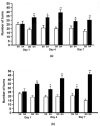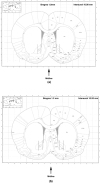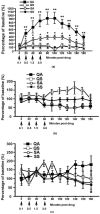Neonatal quinpirole treatment enhances locomotor activation and dopamine release in the nucleus accumbens core in response to amphetamine treatment in adulthood
- PMID: 19953655
- PMCID: PMC2821455
- DOI: 10.1002/syn.20729
Neonatal quinpirole treatment enhances locomotor activation and dopamine release in the nucleus accumbens core in response to amphetamine treatment in adulthood
Abstract
Neonatal quinpirole treatment to rats produces long-term increases in D(2) receptor sensitivity that persists throughout the animal's lifetime, a phenomenon referred to as D(2) priming. Male and female Sprague-dawley rats were administered quinpirole (1 mg kg(-1)) or saline from postnatal days (P)1-11. At P60, all animals were given an injection of quinpirole (100 microg kg(-1)), and results showed that rats neonatally treated with quinpirole demonstrated enhanced yawning in response to quinprole, verifying D(2) receptor priming because yawning is a D(2) receptor mediated event. Beginning 1-3 days later, locomotor sensitization was tested through administration of d-amphetamine (1 mg kg(-1)) or saline every other day over 14 days, and horizontal activity and turning behavior were analyzed. Findings indicated that D(2)-priming enhanced horizontal activity in response to amphetamine in females compared to males at Days 1 and 4 of locomotor sensitization testing, and D(2)-priming enhanced turning in response to amphetamine. Seven to ten days after sensitization was complete, microdialysis of the NAcc core was performed using a cumulative dosing regimen of amphetamine (0.1-3.0 mg kg(-1)). D(2)-primed rats administered amphetamine demonstrated a 500% increase in accumbal DA overflow compared to control rats administered amphetamine. Additionally, amphetamine produced a significant increase in NE overflow compared to controls, but this was unaffected by D(2) priming. These results indicate that D(2) receptor priming as is produced by neonatal quinpirole treatment robustly enhances behavioral activation and accumbal DA overflow in response to amphetamine, which may underlie increases in psychostimulant use and abuse within the psychotic population where increased D(2) receptor sensitivity is a hallmark.
Figures






Similar articles
-
Adolescent nicotine sensitization and effects of nicotine on accumbal dopamine release in a rodent model of increased dopamine D2 receptor sensitivity.Behav Brain Res. 2013 Apr 1;242:102-9. doi: 10.1016/j.bbr.2012.12.037. Epub 2013 Jan 3. Behav Brain Res. 2013. PMID: 23291224
-
Amphetamine-induced enhancement of neostriatal in vivo microdialysate dopamine content in rats, quinpirole-primed as neonates.Pol J Pharmacol. 2001 Jul-Aug;53(4):319-29. Pol J Pharmacol. 2001. PMID: 11990078
-
Nicotine sensitization in adult male and female rats quinpirole-primed as neonates.Psychopharmacology (Berl). 2008 Jul;199(1):67-75. doi: 10.1007/s00213-008-1128-5. Epub 2008 Jun 12. Psychopharmacology (Berl). 2008. PMID: 18548235
-
Ontogenetic quinpirole treatment produces long-lasting decreases in the expression of Rgs9, but increases Rgs17 in the striatum, nucleus accumbens and frontal cortex.Eur J Neurosci. 2007 Nov;26(9):2532-8. doi: 10.1111/j.1460-9568.2007.05860.x. Epub 2007 Oct 23. Eur J Neurosci. 2007. PMID: 17970732
-
Amphetamine locomotor sensitization and conditioned place preference in adolescent male and female rats neonatally treated with quinpirole.Behav Pharmacol. 2011 Aug;22(4):374-8. doi: 10.1097/FBP.0b013e328348737b. Behav Pharmacol. 2011. PMID: 21753255 Free PMC article.
Cited by
-
Transgenerational evidence of increases in dopamine D2 receptor sensitivity in rodents: Impact on sensorimotor gating, the behavioral response to nicotine and BDNF.J Psychopharmacol. 2021 Oct;35(10):1188-1203. doi: 10.1177/02698811211033927. Epub 2021 Jul 22. J Psychopharmacol. 2021. PMID: 34291671 Free PMC article.
-
Crosstalk Between Kappa Opioid and Dopamine Systems in Compulsive Behaviors.Front Pharmacol. 2020 Feb 18;11:57. doi: 10.3389/fphar.2020.00057. eCollection 2020. Front Pharmacol. 2020. PMID: 32132923 Free PMC article. Review.
-
Perinatal Treatments with the Dopamine D₂-Receptor Agonist Quinpirole Produces Permanent D₂-Receptor Supersensitization: a Model of Schizophrenia.Neurochem Res. 2016 Feb;41(1-2):183-92. doi: 10.1007/s11064-015-1757-0. Epub 2015 Nov 7. Neurochem Res. 2016. PMID: 26547196
-
Reinstatement of nicotine conditioned place preference in a transgenerational model of drug abuse vulnerability in psychosis: Impact of BDNF on the saliency of drug associations.Psychopharmacology (Berl). 2023 Jul;240(7):1453-1464. doi: 10.1007/s00213-023-06379-7. Epub 2023 May 9. Psychopharmacology (Berl). 2023. PMID: 37160431 Free PMC article.
-
Eating high fat chow and the behavioral effects of direct-acting and indirect-acting dopamine receptor agonists in female rats.Behav Pharmacol. 2014 Aug;25(4):287-95. doi: 10.1097/FBP.0000000000000052. Behav Pharmacol. 2014. PMID: 24949571 Free PMC article.
References
-
- Abi-Dargham A, Gil R, Krystal J, Baldwin RM, Seibyl JP, Bowers M. Increased striataldopamine transmission in schizophrenia: Confirmation in a second cohort. Am J Psychiatry. 1998;155:761–767. - PubMed
-
- Abi-Dargham A, Kegeles LS, Zea-Ponce Y, Mawlawi O, Martinez D, Mitropoulou V, O'Flynn K, Koenigsberg HW, Van Heertum R, Cooper T, Laruelle M, Siever LJ. Striatal amphetamine-induced dopamine release in patients with schizotypal personality disorder studied with single photon emission computed tomography and [123I]iodobenzamide. Biol Psychiatry. 2004;55:1001–6. - PubMed
-
- Ali SF, Newport GD, Bracha HS. Phencyclidine and (+)-MK-801-induced circling preference: correlation with monoamine levels in striatum of the rat brain. Neurotox. Teratol. 1994;16:35–342. - PubMed
-
- Angelucci F, Mathé AA, Aloe L. Neurotrophic factors and CNS disorders: findings in rodent models of depression and schizophrenia. Prog Brain Res. 2004;146:151–65. - PubMed
-
- Becker JB. Gender differences in dopaminergic function in striatum and nucleus accumbens. Pharm Biochem Behav. 1999;64:803–812. - PubMed
Publication types
MeSH terms
Substances
Grants and funding
LinkOut - more resources
Full Text Sources
